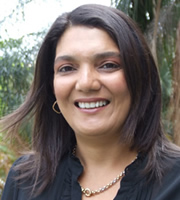| 46% of getS.E.T.go! readers think that the most important benefit of South Africa’s recent participation in the Shanghai Expo, will be the raising of our country’s science & technology profile on the global stage. | |
| 38% opted for “sharing of international best practices in maths & science education”; and 15% for “building an international network of contacts”. |
Almost 21 000 learners from around South Africa and SADC countries participated in the Science Olympiad this year.

She managed to successfully juggle full-time work, part-time studying, three small children and a biological research project all at the same time. No doubt, directing the Durban Natural Science Museum is a cinch for Allison Ruiters.
 |
Q: Tell us about your job at the DNSM I am currently the Director of the DNSM, a position I assumed at the beginning of November 2010. This is more of a homecoming, as I was previously employed at the museum (about three years ago) in the Education Department. My main responsibility is to inform the strategic direction of what is one of the leading natural science museums in southern Africa. However, this can only be achieved with a dedicated team of scientists, administrators, educators, graphic designers and volunteers. They are the glue that makes us a world-class institution, as well as one of the most popular visitor attractions in South Africa! |
Q: What did you do before then?
Prior to joining the DNSM, I was the Director of the Old Mutual-MTN Sciencentre (based at Gateway Theatre of Shopping), a non-profit organisation that exposes learners, educators and the public to high-quality, exciting science and technology experiences. This “interlude” into the science centre world gave me an appreciation of the uniqueness of both science centres and museums. I was able to identify the many areas where they overlap and where they are able to borrow from each other to create distinctive encounters for our visitors.
Q: Where did you grow up?
I was raised in Wentworth, Durban, but studied at the University of Cape Town, majoring in Zoology. This was a good move, given that I met my husband, Shaun, there. I recall a conversation with Professor Jenny Day, shortly after my graduation, when I asked her for career advice. She mentioned a long list of possibilities, one of which was working at a museum. I remember my utter confusion at this prospect. Little did I know that three years later, while pregnant with my second daughter, I would land my first job at the Natal Museum in Pietermaritzburg as their collections manager.
It was here that my fascination and passion for museums developed. The thought of curating a specimen that someone had collected a hundred years ago, identified and carefully preserved, that would in turn contribute to our current research, just blew me away. It made me realise what a unique place museums hold in our communities, and that everyone involved in South Africa’s heritage landscape (whether natural or historical) has a responsibility to make our facilities more widely accessible.
After the Natal Museum, I joined the University of KwaZulu-Natal and registered for my BSc (Hons) in Biological Sciences. I undertook a research project on the “Taxonomic revision of the millipede genus, Orthoporoides”, while still working full-time, with three little ones to look after. To ensure that I didn’t lose too much time with my family, I set up a lab in my dining room with my millipede specimens in jars of alcohol on top of my kitchen cupboard. Once I had put my children to bed, I would then attend to my other “babies”!
Q: What are your future plans?
The DNSM has a bold vision to be a world-class facility in biodiversity sciences, so we will be embarking on a capital campaign to develop a state-of-the-art natural science museum that will build on the success of the current facility. This will make it a local, national and international landmark in both the science, education and tourism sectors. Given that all facets of our institution revolve around our research collections, our plans are to create unique spaces within the museum infrastructure that will enable our visitors to interact with our scientists face-to-face and be exposed, to some extent, to our collections. All this will be reinforced by an interactive science centre, based on the life sciences, ensuring that we are a national beacon of environmental sustainability.
Q: What keeps you busy when you’re not at work?
Spending time with my family and friends is always great – favourite past times are relaxing at the beach on a Sunday, or firing up the braai or potjie. I also enjoy reading and my once-a-month therapy session in the guise of my bookclub, Sedibeng. I love jazz and dancing, so I grab the opportunity whenever I can combine the two. As for food – any dish containing pasta and/or prawns is a favourite!
I have three children, Ashleigh (age 15), Tara (age 13) and Luke (age 6), all of whom bring great joy and meaning to my life. Our parents play a huge role in our family, and my husband and I would not be able to balance our lives without their support. And of course, Shaun has encouraged and supported me throughout this journey. Without him none of this would have been possible.
Q: What excites you most about life?
The realisation that everything happens for a reason. It may not have been obvious to me at the time, but somewhere along my journey I have realised how each moment has prepared me for where I am today. Being a black woman in the science landscape in South Africa today is very exciting, especially given the huge responsibility that comes with this role.
